
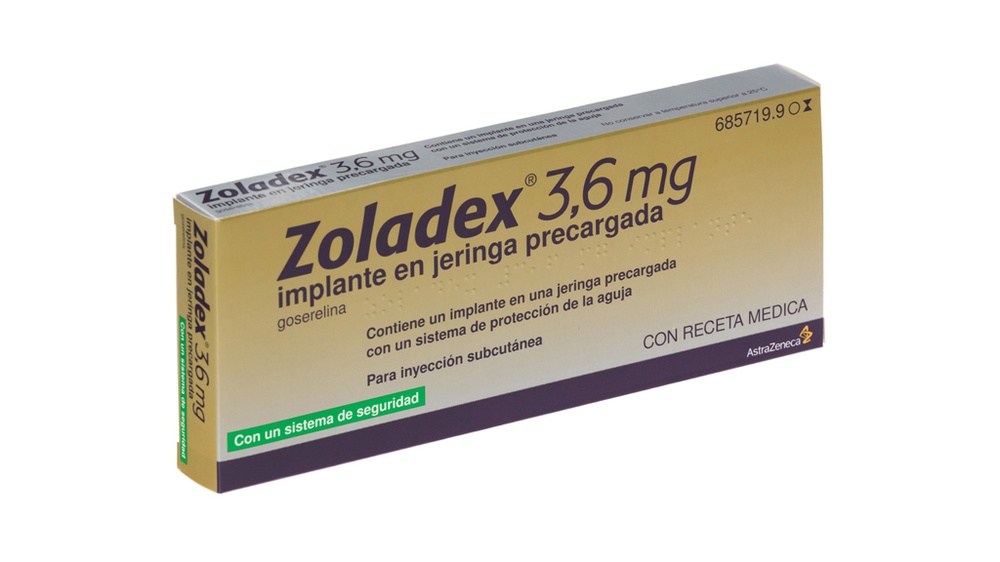
ZOLADEX 3.6 mg IMPLANT IN PRE-FILLED SYRINGE

Ask a doctor about a prescription for ZOLADEX 3.6 mg IMPLANT IN PRE-FILLED SYRINGE

How to use ZOLADEX 3.6 mg IMPLANT IN PRE-FILLED SYRINGE
Introduction
Package Leaflet: Information for the User
Zoladex3.6 mg implant in a pre-filled syringe
goserelin
Read all of this leaflet carefully before you start using this medicine because it contains important information for you.
- Keep this leaflet, you may need to read it again.
- If you have any further questions, ask your doctor or pharmacist.
- This medicine has been prescribed for you only. Do not pass it on to others. It may harm them, even if their signs of illness are the same as yours.
- If you get any side effects, talk to your doctor or pharmacist. This includes any possible side effects not listed in this leaflet. See section 4.
Contents of the pack and other information
- What is Zoladex 3.6 mg and what is it used for.
- What you need to know before you use Zoladex 3.6 mg.
- How to use Zoladex 3.6 mg.
- Possible side effects.
- Storing Zoladex 3.6 mg.
Contents of the pack and further information.
1. What is Zoladex 3.6 mg and what is it used for
Zoladex 3.6 mg belongs to a group of medicines called anti-hormonal medicines, which means it affects the levels of different hormones (naturally produced chemicals) in the body. In men, it will reduce the levels of the male hormone, testosterone, and in women, the levels of the female hormone, estrogen.
Zoladex 3.6 mg is used:
- In men, to treat certain types of prostate cancer.
- In women, to:
- treat certain types of breast cancer.
- treat endometriosis, a non-cancerous disease where tissue that normally grows inside the uterus also grows outside the uterus.
- treat uterine fibroids, non-cancerous growths that develop in the uterus.
- reduce the thickness of the lining of the uterus (endometrium) before undergoing a surgical procedure called endometrial ablation, which involves removing the lining of the uterus.
to control the release of eggs from the ovaries as part of a treatment for infertility.
2. What you need to know before you use Zoladex 3.6 mg
Do not use Zoladex 3.6 mg
- If you are allergic to goserelin or any of the other ingredients of this medicine (listed in section 6).
- Before receiving your injection, tell your doctor if you are pregnant, think you may be pregnant, or are breast-feeding. Zoladex 3.6 mg should not be used if you are pregnant or if you are trying to become pregnant, unless this medicine is used as part of a treatment for infertility. Zoladex 3.6 mg should not be used during breast-feeding (see the section "Fertility, Pregnancy, and Breast-feeding" below).
Warnings and precautions
- Tell your doctor or pharmacist before you start using Zoladex 3.6 mg.
- Depression has been reported in patients taking Zoladex 3.6 mg, which can be severe. If you are taking Zoladex 3.6 mg and experience depression, inform your doctor.
- Tell your doctor if you have any heart or blood vessel disorders or are being treated for them, including medications to control heart rhythm (arrhythmias). The risk of heart rhythm problems may increase when using Zoladex 3.6 mg.
- Tell your doctor if you have high blood pressure.
- Inform your doctor immediately if you experience pain and bruising in the abdomen or other symptoms of severe bleeding, such as difficulty breathing, dizziness, low blood pressure, and/or altered level of consciousness, which could be the result of vascular injuries at the injection site produced during the administration of Zoladex 3.6 mg (see section 4).
- Treatment with Zoladex 3.6 mg may cause positive results in doping tests.
If you are hospitalized, inform the healthcare staff that you are being treated with Zoladex 3.6 mg.
Men:
- Before starting treatment with this medicine, tell your doctor if:
- you have had difficulty urinating or have experienced discomfort in the lower back area, or
- you have diabetes.
- Medicines of this type can cause a loss of calcium from the bones (decrease in bone thickness). If you have any disease that affects the strength of your bones or risk factors for osteoporosis [e.g., chronic alcohol abuse, being a smoker, long-term treatment with anticonvulsants (medicines for epilepsy or convulsions) or corticosteroids (a type of anti-inflammatory medicine), family history of osteoporosis], inform your doctor or nurse.
Women:
- Medicines of this type can cause a loss of calcium from the bones. Part of this loss may be recovered after stopping treatment. If you have any disease that affects the strength of your bones or risk factors for osteoporosis [e.g., chronic alcohol abuse, being a smoker, long-term treatment with anticonvulsants (medicines for epilepsy or convulsions) or corticosteroids, family history of osteoporosis, and malnutrition, such as anorexia nervosa], inform your doctor or nurse, as the reduction in bone mineral density may be more harmful. If you are using Zoladex 3.6 mg for the treatment of endometriosis, your doctor may prescribe additional treatment to counteract this reduction in bone thickness.
- Tell your doctor if you experience vaginal bleeding that does not stop after the first month of treatment with Zoladex 3.6 mg.
- If you are using Zoladex 3.6 mg for the treatment of endometriosis or uterine fibroids, the maximum duration of your treatment with this medicine should not exceed 6 months.
- During treatment with Zoladex 3.6 mg and until your menstrual period is re-established after stopping treatment, you should use contraceptive methods, such as condoms or diaphragms, and never oral contraceptives ("the pill"). This warning does not apply when receiving Zoladex 3.6 mg as treatment for infertility.
Children and adolescents
Zoladex 3.6 mg is not indicated for use in children.
Using Zoladex 3.6 mg with other medicines
Tell your doctor, pharmacist, or nurse if you are using, have recently used, or might use any other medicines.
Zoladex 3.6 mg may interfere with some medicines used to treat heart rhythm problems (e.g., quinidine, procainamide, amiodarone, and sotalol) or may increase the risk of heart rhythm problems when used with other medicines (e.g., methadone (used for pain relief and detoxification from other medicines), moxifloxacin (an antibiotic), antipsychotics (used to treat severe mental illnesses)).
Pregnancy and breast-feeding
If you are pregnant or breast-feeding, think you may be pregnant, or are planning to have a baby, ask your doctor, pharmacist, or nurse for advice before using this medicine.
Zoladex 3.6 mg should not be used if you are pregnant or if you are trying to become pregnant, unless this medicine is used as part of a treatment for infertility. Zoladex 3.6 mg should not be used during breast-feeding.
Driving and using machines
There is no evidence that Zoladex 3.6 mg alters the ability to drive or use machines.
3. How to use Zoladex 3.6 mg
Follow the instructions for administration of this medicine exactly as indicated by your doctor.
If you are in doubt, consult your doctor, pharmacist, or nurse again.
Remember to have your medicine administered to you.
Your doctor will indicate the duration of your treatment with Zoladex 3.6 mg. Do not stop treatment before your doctor tells you to do so.
Zoladex 3.6 mg will be administered to you as an injection by your doctor or nurse, who will follow the instructions on the label of the packaging for correct use.
Zoladex 3.6 mg is normally administered by injection under the skin every 28 days.
It is important that you continue treatment with Zoladex 3.6 mg even if you feel well, unless your doctor decides to stop it.
If you have any further questions on the use of this product, ask your doctor or pharmacist.
4. Possible side effects
Like all medicines, this medicine can cause side effects, although not everybody gets them.
- When administering Zoladex 3.6 mg, the injection may cause an injury at the injection site, including injury to blood vessels in the abdomen. In very rare cases, this has caused severe bleeding. Seek immediate medical attention if you notice any of the following symptoms:
Abdominal pain, abdominal swelling, difficulty breathing, dizziness, low blood pressure, and/or any alteration of the level of consciousness. These could be symptoms of severe bleeding due to accidental injury to an abdominal blood vessel during the administration of Zoladex 3.6 mg.
- Side effects reported in women:
Very common (may affect more than 1 in 10 people)
- Hot flashes, sweating. These side effects may continue after stopping treatment with Zoladex 3.6 mg.
- Decreased sexual desire.
- Vaginal dryness.
- Acne, usually in the first month of treatment with Zoladex 3.6 mg.
- Increased breast size.
- Reactions at the injection site, such as pain, bruising, bleeding, redness, or swelling in the area, or other reactions.
Common (may affect up to 1 in 10 people)
- Numbness or tingling in the fingers of the hands or feet.
- Headaches.
- Changes in blood pressure (elevation or decrease).
- Rash, which is usually mild and resolves without interrupting treatment.
- Hair loss (alopecia), which is usually mild, although occasionally it can be severe and can also occur in young women.
- Joint pain.
- Weight gain.
- Loss of bone mineral density (decrease in bone thickness).
- Mood changes and depression (in prolonged treatments with Zoladex 3.6 mg).
- Exacerbation and pain of the tumor.
Uncommon (may affect up to 1 in 100 people)
- Hypersensitivity reactions to the medicine.
- Increased levels of calcium in the blood, which may manifest with nausea, vomiting, and/or excessive thirst. Inform your doctor if you notice any of these symptoms, as you may need to have a blood test.
- Mood changes and depression (in short treatments with Zoladex 3.6 mg).
Rare (may affect up to 1 in 1,000 people)
- Anaphylactic reaction (severe allergic reaction).
- Ovarian cysts.
Overstimulation of the ovaries when Zoladex 3.6 mg is used as part of a treatment for infertility. If you notice abdominal pain, abdominal swelling, nausea, or vomiting after treatment with these medicines, inform your doctor immediately.
Very rare (may affect up to 1 in 10,000 people)
- Development of a tumor in the pituitary gland (an endocrine gland in the head). If you have a tumor in the pituitary gland, this medicine may cause bleeding from the tumor. Tumors in the pituitary gland can cause headaches, discomfort, vision loss, and even loss of consciousness.
- Psychotic disorders that can cause hallucinations, thought disorders, and personality changes.
Frequency not known (cannot be estimated from the available data)
- Vaginal bleeding at the start of treatment.
- Vaginal inflammation.
- Vaginal discharge.
- If you have breast cancer, you may notice a worsening of your disease, such as increased pain and/or increased size of the affected tissue. These symptoms appear at the beginning and disappear with continued treatment.
- Menopause. After stopping treatment with Zoladex 3.6 mg, you may not have your menstrual period again. It is not known if this is due to the effect of Zoladex.
- If you have uterine fibroids, you may notice a slight increase in symptoms, such as pain. If the symptoms persist or you feel uncomfortable, inform your doctor.
- Alterations in the electrocardiogram (prolongation of the QT interval).
- Changes in the number of blood cells (observed in a blood test).
- Blood clots in the lungs (causing chest pain and difficulty breathing) and inflammation of the tissue surrounding the structures (alveoli) of the lungs where oxygen is absorbed (interstitial pneumonia) (causing symptoms such as cough and difficulty breathing).
- Liver disorder.
- High levels of calcium in the blood, which may appear at the start of treatment in patients with breast cancer and metastases.
- Nervousness, sleep disturbance.
- Fluid retention in the limbs (peripheral edema).
- Voice changes.
- Changes in body hair.
- Nausea, vomiting, diarrhea, constipation, abdominal pain.
- Increased cholesterol in the blood.
- Dry skin.
- Muscle pain.
- Cramps in the calves.
- Fatigue.
- Side effects reported in men:
Very common (may affect more than 1 in 10 people)
- Hot flashes, sweating. These side effects may continue after stopping treatment with Zoladex 3.6 mg.
- Decreased sexual desire and impotence.
Common (may affect up to 1 in 10 people)
- Increased blood sugar levels.
- Mood changes and depression (in prolonged treatments).
- Numbness or tingling in the fingers of the hands or feet (paresthesia).
- Compression of the spinal cord.
- Rash, which is usually mild and often resolves without interrupting treatment.
- Decreased heart function, heart attack. The risk of developing them is higher when Zoladex is used together with other medicines (anti-androgens) to treat prostate cancer.
- Changes in blood pressure (elevation or decrease).
- Bone pain, usually at the start of treatment with Zoladex 3.6 mg. If this happens, inform your doctor, as you may need to be prescribed a medicine to relieve the pain.
- Weight gain.
- Breast swelling.
- Reactions at the injection site, such as pain, bruising, bleeding, redness, or swelling in the area, or other reactions.
- Loss of bone mineral density (decrease in bone thickness).
Uncommon (may affect up to 1 in 100 people)
- Hypersensitivity reactions to the medicine.
- Joint pain.
- Breast tenderness.
- Mood changes and depression (in short treatments).
- Obstruction of the ureters (tubes that carry urine from the kidneys to the bladder), which can cause difficulty urinating or discomfort in the lower back area.
Rare (may affect up to 1 in 1,000 people)
- Anaphylactic reaction (severe allergic reaction).
Very rare (may affect up to 1 in 10,000 people)
- Psychotic disorders that can cause hallucinations, thought disorders, and personality changes.
- Development of a tumor in the pituitary gland (an endocrine gland in the head). If you have a tumor in the pituitary gland, Zoladex 3.6 mg may cause bleeding from the tumor. Tumors in the pituitary gland can cause headaches, discomfort, vision loss, and even loss of consciousness.
Frequency not known (cannot be estimated from the available data)
- Hair loss, especially loss of body hair.
- Alterations in the electrocardiogram (prolongation of the QT interval).
- Changes in the number of blood cells (observed in a blood test).
- Blood clots in the lungs (causing chest pain and difficulty breathing) and inflammation of the tissue surrounding the structures (alveoli) of the lungs where oxygen is absorbed (interstitial pneumonia) (causing symptoms such as cough and difficulty breathing).
- Liver disorder.
Reporting of side effects
If you experience any side effects, talk to your doctor, pharmacist, or nurse. This includes any possible side effects not listed in this leaflet. You can also report side effects directly through the Spanish Pharmacovigilance System for Human Use Medicines: www.notificaRAM.es. By reporting side effects, you can help provide more information on the safety of this medicine.
5. Storing Zoladex 3.6 mg
Keep this medicine out of the sight and reach of children.
Do not store above 25°C.
Store in the original packaging.
Do not use Zoladex 3.6 mg after the expiry date which is stated on the packaging and outer carton after EXP. The expiry date is the last day of the month stated.
Medicines should not be disposed of via wastewater or household waste. Ask your pharmacist how to dispose of medicines no longer required. These measures will help protect the environment.
6. Container Contents and Additional Information
Composition of Zoladex 3.6 mg
- The active ingredient is goserelin (as acetate). Each implant contains 3.6 mg of goserelin.
- The other component is lactic-glycolic copolymer.
Appearance of the Product and Container Contents
The medication is presented in the form of a 3.6 mg implant in a pre-loaded syringe within a sealed envelope.
The implant is sterile, cream-colored, and releases the drug in a prolonged manner.
The envelope contains a desiccant inside, in addition.
The pre-loaded syringe has a safety device (red clip) and a needle protection system.
Marketing Authorization Holder and Manufacturer
Marketing Authorization Holder
AstraZeneca Farmacéutica Spain, S.A.
C/ Puerto de Somport 21-23
28050 Madrid
Spain
Manufacturer
AstraZeneca AB
Gärtunavägen
SE-152 57 Södertälje
Sweden
Other Presentations
Zoladex Trimestral 10.8 mg: Container containing a 10.8 mg implant in a pre-loaded syringe within a sealed envelope, which also contains a desiccant inside. The pre-loaded syringe has a safety device (blue clip) and a needle protection system.
Date of the Last Review of thisProspectus: February 2020
Detailed and updated information about this medication is available on the website of the Spanish Agency for Medicines and Health Products (AEMPS) http://www.aemps.gob.es/
<----------------------------------------------------------------------------------------------------------------------------------?
This information is intended only for healthcare professionals:
Zoladex 3.6 mg should be administered via subcutaneous injection – read and understand all instructions completely before administration.
- Lay the patient in a comfortable position, with the upper body slightly elevated. Clean the abdominal injection site with a cotton swab impregnated with a disinfectant agent (alcohol, etc.).
NOTE: Caution should be exercised when proceeding with the injection of Zoladex 3.6 mg in the anterior abdominal wall, due to the proximity of the underlying inferior epigastric artery and its branches. Very thin patients may have a high risk of vascular injury.
- Examine the envelope and syringe for any damage. Remove the syringe from the open envelope and hold it at an angle towards the light.
Check that at least part of the Zoladex 3.6 mg implant is visible. (Figure 1).
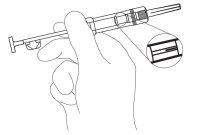 Figure 1
Figure 1
- Gently remove the red plastic safety tab from the syringe and discard it. (Figure 2).
Remove the cap that protects the needle. As it is not a liquid injectable, there is no need to eliminate air bubbles, as attempting to do so could displace the Zoladex 3.6 mg implant.
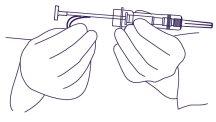 Figure 2
Figure 2
- Hold the syringe around the protection system, using an aseptic technique. Take a skin fold of the patient and insert the needle at a slight angle of inclination (30 to 45 degrees).
With the needle opening facing upwards, insert the needle into the subcutaneous tissueof the anterior abdominal wall below the navel line, until the protection system touches the patient's skin. (Figure 3).
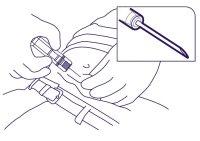 Figure 3
Figure 3
NOTE: The Zoladex 3.6 mg syringe cannot be used for aspiration. If the hypodermic needle penetrates a large vessel, blood will be seen instantly in the syringe chamber. If a vessel is penetrated, remove the needle and immediately control any resulting bleeding, monitoring the patient for any signs or symptoms of abdominal hemorrhage. After ensuring the patient is hemodynamically stable, another Zoladex 3.6 mg implant can be injected with a new syringe in another area. Exercise extreme caution when administering Zoladex 3.6 mg to patients with a low BMI and/or to patients receiving full anticoagulant doses.
- Do not penetrate the muscle or peritoneum.In Figure 4, below, an incorrect holding and exposure angle are shown.
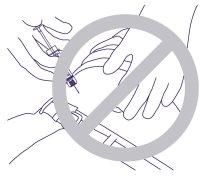 Figure 4
Figure 4
- Press the plunger completely, until it can no longer be pressed, in order to deposit the Zoladex 3.6 mg implant and activate the protection system. A "click" may be heard and the protection system may be felt sliding automatically to cover the needle. If the plunger is not pressed completely, the protection system WILL NOTbe activated.
NOTE:The needle does not retract.
- Continue holding the syringe as shown in Figure 5, remove the needle, allowing
the protection system to continue sliding and covering the needle.
Discard the syringe in a container, in accordance with local regulations.
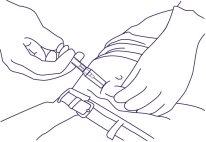 Figure 5
Figure 5
NOTE: In the unlikely event of the need for surgical removal of a Zoladex 3.6 mg implant, it can be located by ultrasound.

How much does ZOLADEX 3.6 mg IMPLANT IN PRE-FILLED SYRINGE cost in Spain ( 2025)?
The average price of ZOLADEX 3.6 mg IMPLANT IN PRE-FILLED SYRINGE in December, 2025 is around 106.31 EUR. Prices may vary depending on the region, pharmacy, and whether a prescription is required. Always check with a local pharmacy or online source for the most accurate information.
- Country of registration
- Average pharmacy price106.31 EUR
- Active substance
- Prescription requiredYes
- Manufacturer
- This information is for reference only and does not constitute medical advice. Always consult a licensed doctor before taking any medication. Oladoctor is not responsible for medical decisions based on this content.
- Alternatives to ZOLADEX 3.6 mg IMPLANT IN PRE-FILLED SYRINGEDosage form: IMPLANT, 10.8 mgActive substance: goserelinManufacturer: Astrazeneca Farmaceutica Spain S.A.Prescription requiredDosage form: INJECTABLE, 42 mgActive substance: leuprorelinManufacturer: Accord Healthcare S.L.U.Prescription requiredDosage form: INJECTABLE, 0.1 mgActive substance: triptorelinManufacturer: Ipsen Pharma S.A.Prescription required
Alternatives to ZOLADEX 3.6 mg IMPLANT IN PRE-FILLED SYRINGE in other countries
The best alternatives with the same active ingredient and therapeutic effect.
Alternative to ZOLADEX 3.6 mg IMPLANT IN PRE-FILLED SYRINGE in Poland
Alternative to ZOLADEX 3.6 mg IMPLANT IN PRE-FILLED SYRINGE in Ukraine
Online doctors for ZOLADEX 3.6 mg IMPLANT IN PRE-FILLED SYRINGE
Discuss dosage, side effects, interactions, contraindications, and prescription renewal for ZOLADEX 3.6 mg IMPLANT IN PRE-FILLED SYRINGE – subject to medical assessment and local rules.











